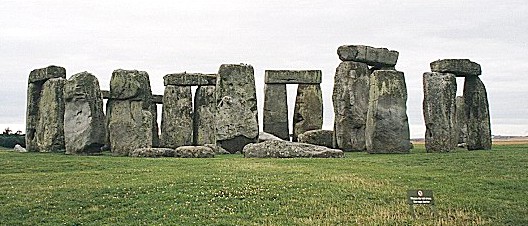 The original purpose of Stonehenge, located on the Salisbury Plain in Wiltshire, England, is unclear, as is the identity of the people who constructed it. We know that the layout of the massive stones served as an astronomical observatory for marking the position of celestial objects, and predicting solstices and eclipses, probably in order to maintain a calendar of significant events. The stones we see today represent only a fraction of the original Stonehenge. Many of the original stones have fallen, or been removed by previous generations for home construction or road repair. There was also considerable damage done to some of the stones due to visitors, prior to 1978 (close contact is now not allowed). In its day, the construction of Stonehenge was an impressive engineering feat, requiring much time and huge amounts of manual labour, and utilizing sledges, rollers, ropes, and barges. Stonehenge was built in several stages, from 2800 - 1800 BC. In its first phase, Stonehenge was a large earthen ditch called a henge, constructed approximately 5,000 years ago. The ditch was probably dug with tools made from wood and the antlers of deer. The underlying chalk was loosened with picks and shoveled out, to be loaded into baskets and carried away. About 2,000 BC, the first stone circle (which is now the inner circle), was set up, but abandoned before completion. These 'bluestones', about 80 of them in the original inner circle, weighed up to 3 tonnes each and were probably brought from the Prescelly Mountains, located roughly 380 km away. The giant sarsen stones (which form the outer circle), weigh as much as 39 tonnes each. They were brought from the Marlborough Downs, roughly 32 km north of the site, lowered into holes, and their bases were packed with loose stones. Once on the site, huge lintel stones were added to the tops. This massive effort required hundreds of men. Stonehenge was probably finally completed around 1500 BC. We don't know for sure who built Stonehenge, although we're pretty sure it was not the druids, who came to England long after Stonehenge had been completed. A current theory is that the Stonehenge site was begun by the people of the late Neolithic period (around 3000 BC) and continued by later peoples who inhabited the region. |